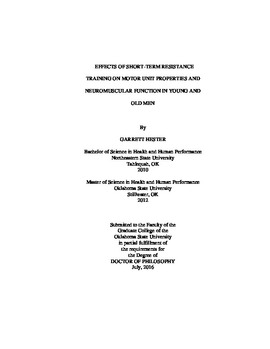| dc.contributor.advisor | DeFreitas, Jason | |
| dc.contributor.author | Hester, Garrett | |
| dc.date.accessioned | 2017-02-22T22:09:32Z | |
| dc.date.available | 2017-02-22T22:09:32Z | |
| dc.date.issued | 2016-07 | |
| dc.identifier.uri | https://hdl.handle.net/11244/48814 | |
| dc.description.abstract | Aging is accompanied by decreases in neuromuscular functioning that can lead to decreased mobility and quality of life in older adults. The purpose of this study was two-fold: 1) To investigate the age-related differences in maximum motor unit firing rates and motor unit action potential size. 2) To examine the effects of short-term resistance training on motor unit properties and neuromuscular function in young and old men. Twenty-five young (range: 18-30) and twenty-three older adults (range: 55-88 yrs) volunteered to participate in this study and were randomly assigned to either a training or control group. The training groups performed 3 sessions of unilateral resistance training per week for 4 weeks, while the control group only performed the testing. Testing was performed for the trained and untrained leg before (PRE), after 2 weeks (MID), and after 4 weeks (POST) of training. Motor unit properties including maximum motor unit firing rates (MaxFR), motor unit action potential size (MUAP-size), and recruitment threshold (RT) were obtained through the use of decomposing surface electromyography. Linear regression was used for the MaxFR and RT as well as the MUAP-size relationship in order to obtain slope coefficients (MaxFRSLOPE and MUAP-sizeSLOPE, respectfully). In addition, strength, peak velocity (PV), rate of velocity development (RVD), and rate of muscle activation (RER) were measured during each testing visit. Older adults exhibited a decreased MUAP-sizeSLOPE at PRE compared to younger adults, but MaxFRSLOPE was similar between groups. MaxFRSLOPE increased at MID and POST, while MUAP-sizeSLOPE increased at POST in both groups with no age-related differences being demonstrated for either. Older adults exhibited an attenuated response to the training as young training group demonstrated larger gains after 2 and 4 weeks of resistance training. While RVD (unloaded knee extension) for the trained leg remained unchanged, it increased for the untrained leg in both, the young and old training group. These findings provide preliminary evidence of aging- and training-related alterations in MU morphology Also, new information was provided that may contribute to understanding the functional implications for cross-education. | |
| dc.format | application/pdf | |
| dc.language | en_US | |
| dc.rights | Copyright is held by the author who has granted the Oklahoma State University Library the non-exclusive right to share this material in its institutional repository. Contact Digital Library Services at lib-dls@okstate.edu or 405-744-9161 for the permission policy on the use, reproduction or distribution of this material. | |
| dc.title | Effects of short-term resistance training on motor unit properties and neuromuscular function in young and old men | |
| dc.contributor.committeeMember | Smith, Douglas Boyd | |
| dc.contributor.committeeMember | Warren, Aric Jon | |
| dc.contributor.committeeMember | Davis, Robert Evan | |
| osu.filename | Hester_okstate_0664D_14820.pdf | |
| osu.accesstype | Open Access | |
| dc.type.genre | Dissertation | |
| dc.type.material | Text | |
| thesis.degree.discipline | Health, Leisure and Human Performance | |
| thesis.degree.grantor | Oklahoma State University | |
